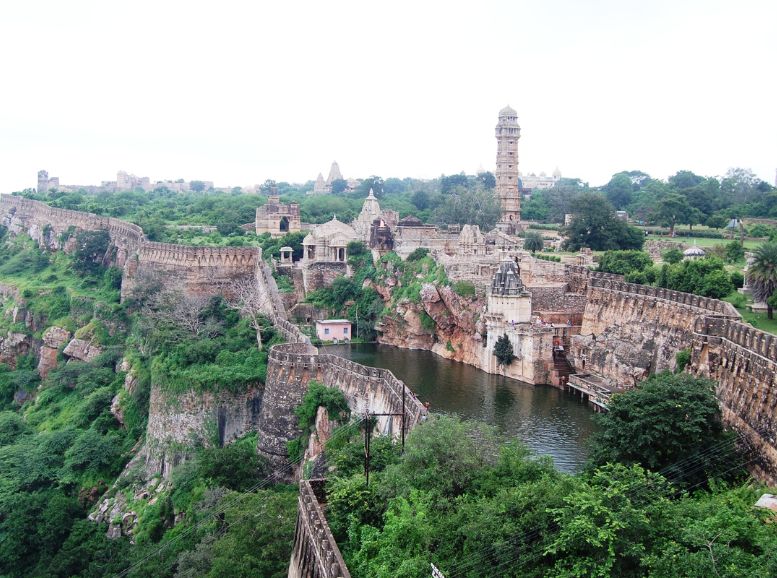Chittorgarh Fort, a colossal monument in Rajasthan, India, embodies the valor of Rajput warriors through its rich history, architectural wonders, and cultural significance. Join us on a journey to explore this sprawling fort, where legendary tales like Rani Padmini’s bravery interweave with architectural marvels like the Vijay Stambha, and every corner whispers secrets of a glorious past.
How to reach:
By Air:
The nearest airport to Chittorgarh Fort is Maharana Pratap Airport in Udaipur, located approximately 90 kilometers away. From the airport, you can hire a taxi or take a bus to reach Chittorgarh.
By Train:
Chittorgarh is well-connected by rail, with regular trains running from major cities like Delhi, Mumbai, Jaipur, and Udaipur. Chittorgarh Junction Railway Station is situated close to the fort, making it convenient for travelers to reach their destination.
By Road:
Chittorgarh is accessible by road via well-maintained highways. State-run buses, as well as private buses, operate from nearby cities like Udaipur, Jaipur, and Delhi. Additionally, you can also opt for private taxis or self-drive cars to reach Chittorgarh.
Local Transport:
Once you reach Chittorgarh, you can hire auto-rickshaws, taxis, or cycle-rickshaws to reach Chittorgarh Fort. The fort is located atop a hill, so if you prefer a more adventurous option, you can trek up to the fort enjoying the scenic views along the way.
Best time to visit:
Winter (October to March):
- Pleasant weather: Ideal for sightseeing with comfortable temperatures (20°C to 25°C).
- Festivals and events: Immerse yourself in local culture with festivals like the Chittorgarh Fort Festival.
- Crystal clear skies: Perfect for capturing stunning photos of the fort’s architecture and panoramic views.
Spring (March to May):
- Warming temperatures: Enjoy outdoor activities with manageable daytime temperatures (25°C to 35°C).
- Blooming landscapes: Witness the vibrant flora and lush greenery of the fort’s surroundings.
- Plan your visit: Opt for early mornings or late afternoons to avoid the peak heat of the day.
Monsoon (June to September):
- Dramatic scenery: Lush landscapes emerge with heavy rainfall, creating a picturesque backdrop.
- Be prepared for rain: Monsoon showers can impact sightseeing and outdoor activities. Expect humidity and occasional disruptions.
Attractions:
Vijay Stambha (Victory Tower):
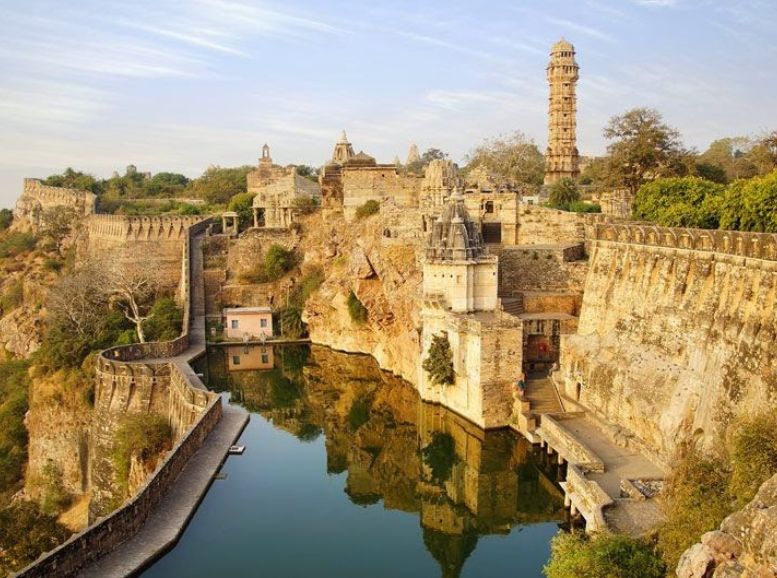
A towering symbol of victory, the Vijay Stambha stands as a testament to Maharana Kumbha’s triumph over the Malwa and Gujarat armies. This intricately carved victory tower, reaching 37 meters high, offers breathtaking panoramic views of the surrounding landscape. Each floor boasts unique architectural details, whispering stories of the fort’s glorious past.
Kirti Stambha (Tower of Fame):
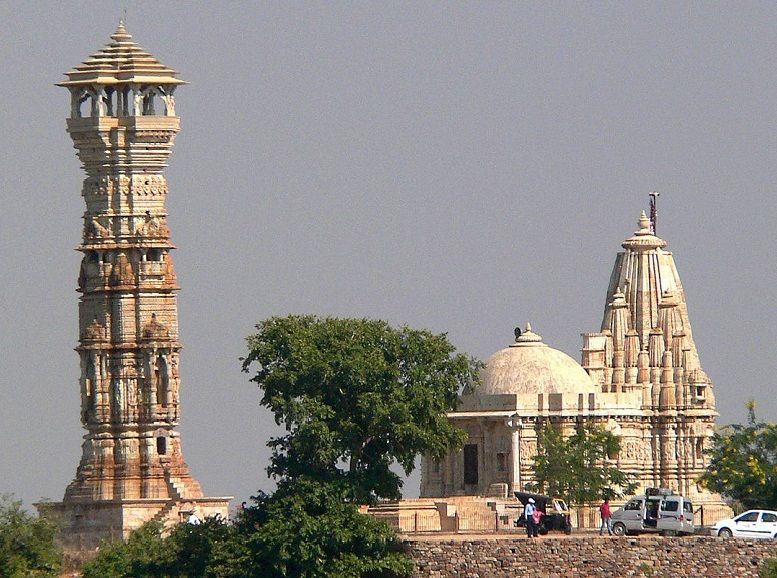
Standing 22 meters tall, Kirti Stambha is a monument to Jainism, adorned with exquisite sculptures of deities and symbolic motifs. Built in the 12th century by a Jain merchant, the tower reflects both the religious openness and artistic mastery of its time.
Rana Kumbha Palace: Chittorgarh Fort
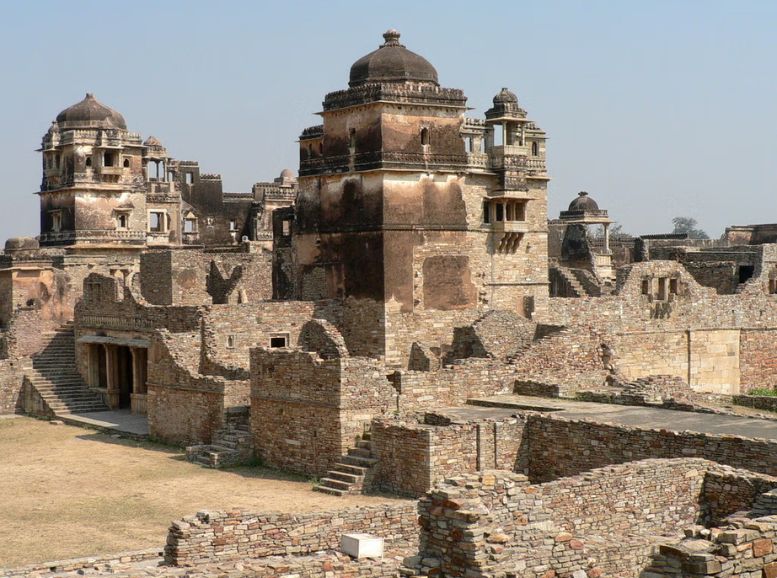
Named after Maharana Kumbha, the imposing Rana Kumbha Palace complex exemplifies Rajput architectural brilliance. Though weathered by time, the palace retains its majesty. Intricately carved pillars, filigreed balconies, and expansive courtyards whisper tales of a bygone era. Visitors can wander through these halls, once bustling with life, and envision the grandeur of past courtly ceremonies. The palace complex also houses a museum, showcasing artifacts that illuminate the region’s rich history and cultural heritage.
Padmini Palace:
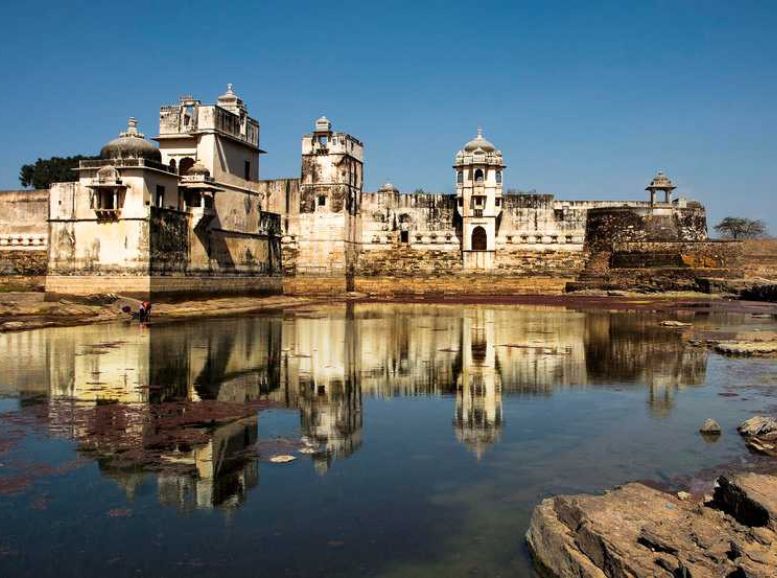
Shrouded in legend, the palace is believed to be the former residence of Rani Padmini, whose beauty is said to have triggered the siege of Chittorgarh by Alauddin Khilji. Tranquil water bodies embrace the palace grounds, offering mesmerizing vistas of the surrounding landscape.
Exquisite carvings grace the palace walls, whispering tales of bygone eras through depictions of historical and mythological scenes. Today, the palace stands as a testament to a vibrant past, inviting visitors to wander its halls and courtyards, and to lose themselves in the echoes of its rich history.
Meera Temple:
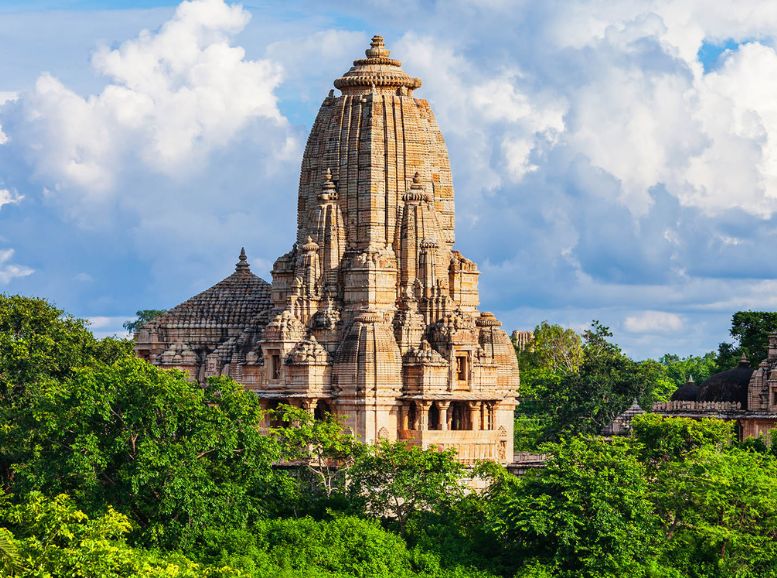
Steeped in devotion, the Meera Bai Temple is a hallowed sanctuary for admirers of the 16th-century mystic poetess, Meera Bai. Enshrined within are exquisite idols of Meera Bai and Lord Krishna, drawing pilgrims seeking spiritual solace and blessings. The temple’s tranquil atmosphere fosters contemplation, inviting visitors to immerse themselves in devotional chants and hymns that often fill the air. Meera Bai’s stirring poetry and unwavering devotion to Krishna come alive within the temple walls, creating a powerful spiritual experience.
Kalika Mata Temple:
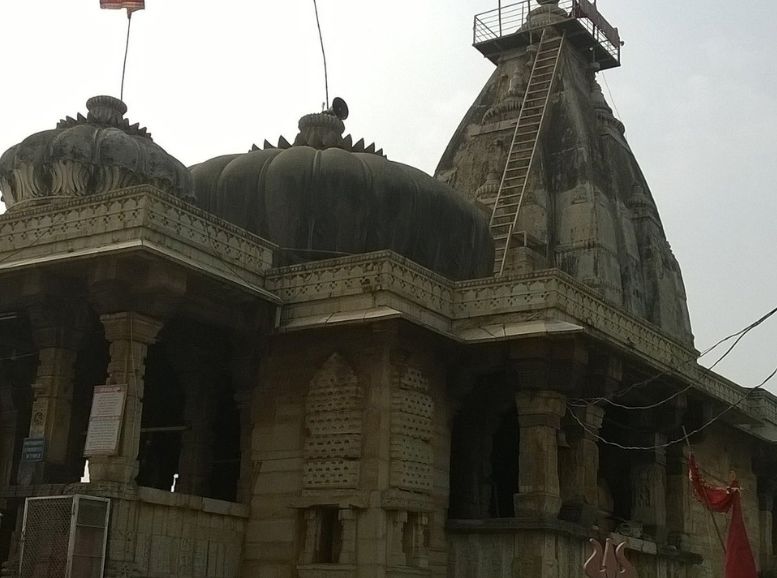
Commanding a presence near the fort’s main gate, this ancient temple is dedicated to the enigmatic Kali, the Hindu goddess of power and transformation. The temple’s architecture and intricate carvings captivate visitors, each detail a testament to the artistry and devotion of its creators.
Gaumukh Reservoir:
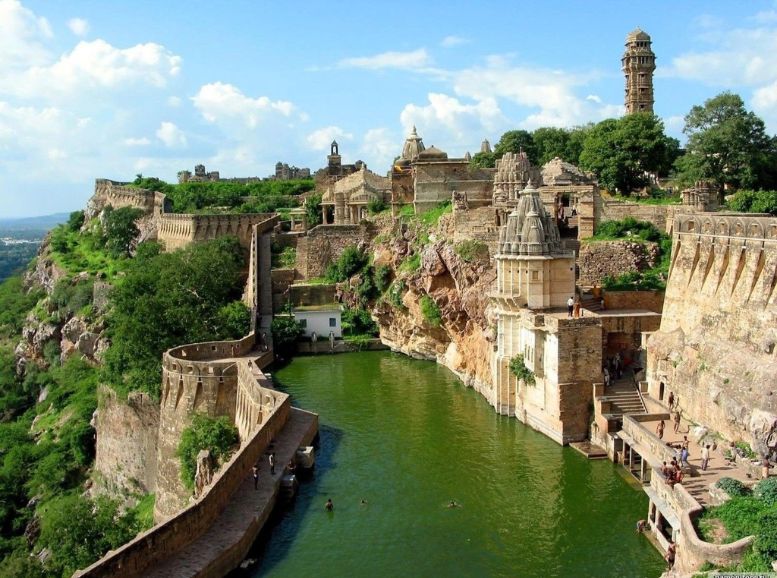
A vital lifeline within the fort walls, Gaumukh (literally “cow’s mouth”) is a natural spring believed to be the primary source of water for Chittorgarh’s residents for centuries. True to its name, water flows from a spout carved to resemble a cow’s head, filling the reservoir below. This sacred site holds immense historical significance, a testament to the fort’s strategic planning and enduring resilience. Even today, visitors marvel at the constant flow of water, a symbol of life and perseverance in this ancient citadel.
Local Experiences:
Immerse Yourself in Local Life: Chittorgarh offers more than just historical wonders. Mingle with shopkeepers and artisans, learning about their way of life and age-old traditions passed down through generations. Strike up conversations to discover the heart and soul of this vibrant region.
Witness Rajasthan’s Cultural Brilliance: Keep your eyes peeled for captivating cultural performances. From the rhythmic beats of folk music and mesmerizing dance routines to traditional puppet shows and captivating storytelling sessions, these events transport you to the heart of Rajasthani artistry.
A Culinary Adventure Awaits: Embark on a flavor safari by indulging in regional delicacies. Sample local fare at bustling street stalls, charming eateries, and renowned restaurants near the fort. Don’t miss iconic Rajasthani dishes like dal baati churma, a comforting combination of lentils, dumplings, and fried crumbs, or gatte ki sabzi, a flavorful chickpea flour curry. Spice things up with laal maas, a fiery red meat curry – a true explosion of taste.
Unearth Local Treasures: Delve into the vibrant markets surrounding the fort, brimming with traditional Rajasthani handicrafts. From intricately woven textiles and exquisite pottery to eye-catching jewelry and handcrafted leather goods, there’s something for everyone. Support local artisans by taking home unique souvenirs that embody the region’s artistic legacy.
Explore the Countryside: Venture beyond the fort’s embrace to discover the captivating villages and scenic landscapes that paint a picture of rural Rajasthan. Join a guided village tour or enlist the help of a local guide to navigate charming communities, witness age-old customs, and gain a glimpse into everyday life.
Become an Apprentice: Channel your inner artisan by participating in workshops led by local experts. Learn the secrets behind block printing, pottery making, or traditional Rajasthani cooking from skilled craftspeople. Immerse yourself in these time-honored traditions and take home a newfound appreciation for their artistry.
Embrace Spirituality: Explore the network of temples and shrines that dot the Chittorgarh region, each one holding immense religious and cultural significance for the local community. Witness ongoing rituals and ceremonies to gain a deeper understanding of the region’s rich spiritual tapestry.
Experience Authentic Hospitality: Opt for a stay in a heritage homestay or guesthouse managed by local families. Savor delectable home-cooked meals, participate in cultural activities, and share stories with your hosts for an unforgettable experience that captures the true essence of Rajasthani hospitality.
Travel tips:
Do Your Research: Delve into the rich history of Chittorgarh Fort beforehand. Familiarize yourself with its key attractions, opening hours, and any ongoing events or exhibitions. Plan your itinerary to ensure you see everything that sparks your interest and make the most of your visit.
Dress for Exploration: Remember, Chittorgarh Fort demands comfortable clothing and sturdy footwear. Opt for breathable fabrics and shoes suitable for navigating uneven terrain and climbing stairs.
Stay Hydrated: Rajasthan’s climate can be unforgiving. Pack a refillable water bottle and stay hydrated throughout your exploration, especially during the warmer months.
Beat the Heat: Embrace sun protection! Pack sunscreen, a wide-brimmed hat, and sunglasses to shield yourself from the sun’s intense rays.
Respect the Culture: Chittorgarh Fort holds historical and religious significance. Dress modestly and behave respectfully while visiting temples and other sacred sites.
Mind Your Camera: Photography restrictions might be in place within specific areas, particularly temples and shrines. Always seek permission before capturing photos, and adhere to any posted guidelines.
Become a Savvy Shopper: If souvenir hunting is on your agenda, prepare to bargain politely but fairly near the fort. Research typical price ranges beforehand to ensure a mutually agreeable transaction.
Conclusion
In essence, a visit to Chittorgarh Fort is a captivating odyssey through Rajasthan’s illustrious past, curated by Xplro.com. Here, valor, resilience, and cultural richness intertwine, unfolding from the towering Vijay Stambha to the serene temples and palaces within. Every corner whispers tales of royalty and bravery. But Chittorgarh Fort transcends mere history. Xplro.com can help you craft an itinerary that unlocks immersive cultural experiences, from conversing with locals to savoring Rajasthani delicacies and participating in artistic workshops. As visitors depart this magnificent citadel, they carry not just memories of its grandeur, but a deeper appreciation for Rajasthan’s timeless heritage and the unwavering spirit of its people.
FAQs
- What is Chittorgarh Fort?
- Chittorgarh Fort is a colossal fortress situated in Rajasthan, India, renowned as one of the country’s largest forts and a UNESCO World Heritage Site.
- What is the historical significance of Chittorgarh Fort?
- With origins dating back to the 7th century AD, Chittorgarh Fort served as the capital of the Mewar Kingdom. It witnessed numerous battles, including the legendary siege by Alauddin Khilji in 1303.
- What are the prominent attractions within Chittorgarh Fort?
- Key attractions within the fort include Vijay Stambha, Kirti Stambha, Rana Kumbha Palace, Padmini Palace, Meera Temple, and Kalika Mata Temple, each bearing testimony to the fort’s historical and architectural significance.
- How long does it take to explore Chittorgarh Fort?
- Typically, exploring the major attractions within Chittorgarh Fort requires approximately 4-6 hours, though duration can vary based on individual interests and pace.
- What are the visiting hours of Chittorgarh Fort?
- Chittorgarh Fort welcomes visitors from sunrise to sunset every day, but specific timings may vary, so it’s advisable to verify the current schedule before planning your visit.
- Is there an admission fee to enter Chittorgarh Fort?
- Yes, an entry fee is applicable for visitors, with different rates for Indian and foreign tourists. Additional charges may apply for cameras and video equipment.
- Are guided tours available at Chittorgarh Fort?
- Yes, professional guides are available for hire at Chittorgarh Fort. They offer valuable insights into the fort’s history, architecture, and cultural significance.
- What accommodation options are nearby Chittorgarh Fort?
- Nearby accommodations include hotels, guesthouses, and heritage properties. Advance reservations are recommended, especially during peak tourist seasons.
- When is the best time to visit Chittorgarh Fort?
- The ideal time to visit is during the winter months, from October to March, when the weather is pleasant, facilitating comfortable exploration.
- How can I reach Chittorgarh Fort?
- Chittorgarh Fort is accessible via road, rail, and air. The nearest airport is Maharana Pratap Airport in Udaipur, while Chittorgarh Junction serves as the closest railway station. Buses and taxis are available from nearby cities.
- Are dining options available within Chittorgarh Fort?
- While there are no restaurants within the fort premises, several eateries and food stalls are situated nearby, offering traditional Rajasthani cuisine and refreshments.
- Is Chittorgarh Fort wheelchair accessible?
- Due to its uneven terrain and numerous steps, Chittorgarh Fort may present challenges for wheelchair users. However, some areas may be accessible with assistance, and visitors are advised to inquire about accessibility options beforehand.


